
32 minute read
Tell the Truth
Power and Language in Psychiatry
Between solitary confinement and assisted living there is a spectrum of power dynamics. The conceptual pair ‘power and powerlessness’ run through the history of psychiatry up to and including its practice today: from powerlessness in respect of one’s thoughts or delusions, compulsive behaviour or offering appropriate help to a loved one, to the relationships between pharmaceutical companies and the scientific agenda, or deciding where the couch and chair go in the psychiatrist’s consulting room. There are measures that restrict freedom of movement. There are institutions you can’t just enter and leave.
Psychiatric power and powerlessness were and are most visible in the form of confinement, when chains and shackles are used, when patients wear a gown or straitjacket, receive orders, have to be silent, or scream in isolation. But there are also less visible forms of power, such as authoritative theories and current therapies and diagnoses. Power dynamics are intrinsic in the way psychiatry works.
In many respects, the history of psychiatry and the issues it has to deal with today have to do with speaking, with the discourse in which psychiatry functions. What meaning is given to words? To what diagnoses do they lead? Is someone who is quiet calm, or is he or she suffering from aphasia? Do we talk about psychiatric illness or psychic vulnerability? Are those who had ‘weak nerves’ in the early twentieth century people who are now ‘hypersensitive’? How trustworthy is what someone says if he or she has been diagnosed as non compos mentis? How do you deal with a request for euthanasia from someone who suffers from depression? In those sometimes deafening, sometimes whispered words, the tension between power and powerlessness is revealed. Where do we find the traces of those words, fresh or faded, and what significance do we dare give to them?
‘MADMEN’
The way in which power, language and psychiatry are interrelated lies at the heart of the psychiatric movement with the generalised and hyperbolical name of ‘antipsychiatry’, which flourished in the 1960s and 1970s. The criticism was strong: it was directed at the medical model that was central to classical psychiatry, at overcrowded institutions, at the anonymity of patients and the authority of the psychiatrist. Mediagenic figures such as Ronald Laing, Franco Basaglia and, in Belgium, Steven De Batselier expressed this criticism convincingly in public and at the same time linked it to alternatives. ‘Sous les pavés, la plage’: that slogan of the protestors in May 1968, who saw the beach — freedom — under figurative paving stones — the heavily normative surface —, also applied the critical approach to psychiatry. The alternatives were to be found under the worn paving stones in crowded, noisy psychiatric dormitories. Antipsychiatrists provided a new, conceptual framework to deal with mental illness, like an inner journey, as Laing had suggested. They succeeded in bringing about farreaching legislative reforms, like the ‘Basaglia Act’ which closed psychiatric institutions in Italy, and they set up smallscale therapeutic communities, like De Batseliers Passage 144 in Leuven.
The critical, antipsychiatry movement wrote itself into the history books. Not just because of the substance of the criticism, but also because of the way in which that criticism was expressed. Not in ornamental handwriting from a psychiatrist’s fine fountain pen in which patient details had been noted down in dusty dossiers for a century, but with a spray can, and with graffiti slogans that occupied the public space. Suddenly, discussions about ECT (electroconvulsive therapy) and psychotropic drugs were no longer restricted to a select circle of specialists, but were being conducted by the man in the street. The criticism of the old psychiatric institutions was picked up by film and photography. Power acquired the face of Nurse Ratched, the character from Miloš Forman’s film adaptation of Ken Kesey’s novel One Flew Over the Cuckoos Nest (1962), and the interior of the psychiatric institution was revealed by documentary photo series like those of Raymond Depardon and Jerry Cooke.
Language was, furthermore, a central aspect in the critical movement in two ways. Firstly, a new language was developed as an alternative to the authoritarian medical jargon. Not the diagnostic terminology of psychiatrists, but a literaryphilosophical
Hanging chair used in prenatal psychodynamics, undated, rattan. Dr. Guislain Museum, Ghent
Leuven-based criminologist and psychologist Steven De Batselier (1932–2007) was well known as a troublemaker. He repeatedly clashed with authority figures. He set up Passage 144, a small-scale residential community for psychiatric patients that sought to offer an alternative to hierarchical, anonymous psychiatric hospitals. He criticised conventional psychiatry and questioned treatments such as electric shock therapy. In Passage 144, De Batselier created a space for prenatal psychodynamics, where the birth trauma was seen as the basis of psychoses. Residents were rocked in a hanging chair like babies in their mother’s womb.
language. Not Emil Kraepelin, but JeanPaul Sartre was a source of inspiration, and not the chemical formulas of the first antipsychotic drugs, but sonnets (Laing) and Bildungsromane (Jan Foudraine’s Not Made of Wood). Secondly, the critical psychiatrists broke with the then current discourse about the value attached to the patient’s opinion. The patient’s voice was almost entirely absent in the debate about psychiatry: they were talked about, but never spoke. In the 1960s and 1970s, increased attention was paid to what patients themselves had to say about their experience. The often critical testimonies were published and read with interest.
A publication such as the Gekkenkrant (Madmen’s newspaper) in the Netherlands is a wellknown example. The DIY newspaper ‘for and by psychiatric patients’, combined a critical, emancipatory and playful approach, and achieved effective changes. Patients had a platform from which they could speak freely about their situation. The initiative expressed great faith in the power of the word. As the editorial team wrote in retrospect: ‘We thought that life in the institutions had to be central. If people had the opportunity to communicate with each other by means of a newspaper, then political and social awareness would follow as a matter of course. (...) The editorial team didn’t have to do much more than make a newspaper available’ (1978, no. 26).
Breaking the power of the psychiatric discourse doesn’t happen by itself, however. The success of the resistance that the protest movement initiated was also its downfall. The belief in the power of the word ensured that the movement increasingly got stranded in a metadiscourse in which it was more about the words themselves than about the reality they described. When the celebrated antipsychiatrists met in Leuven in 1981 to plan for the future, for example, the congress that was supposed to develop a ‘strategy of the small scale’ was considered too large, and while patient participation is a crucial element of the philosophy, even that showed its limits when a patient attending the congress decided to intervene and the schedule was so disrupted that he was escorted off the premises. Ultimately, a congress about resistance mutated into resistance against the congress.
This also happened with the Gekkenkrant, the ‘Madmen’s newspaper’. According to the editorial team, the pages were filled with too much discussion about the name of the paper itself: was the term ‘Madmen’ appropriate or not, did it express resistance or repeat a stigma? Quotation marks were added and Gekkenkrant

Gekkenkrant, 1977, year 3, paper.
Vereniging Canon Sociaal Werk, Amsterdam. Dr. Guislain Museum, Ghent
The Gekkenkrant (Madmen’s newspaper) (1973–1981) presented itself as a critical newspaper ‘for and by crazy people’ and functioned as a creative practice with a strong sense of the homemade. The paper became a milestone on the journey towards greater empowerment and participation of patients in the organisation of (institutional) psychiatry. It contained a huge variety of contributions: some heartbreaking, others carnivalesque and yet others experimental, like that of PyQuRus, the nom de plume of engineer P. Kuperus. He communicated in a language of his own invention. Dutch critic Jacq Vogelaar wrote about these texts: ‘By appropriating or embodying a language—or obscuring it: stealing what once belonged to them or has been denied them— a language emerges (a linguistic world of their own) within language.’
became ‘Gekken’krant, but the signposting of irony and parody did not end the discussion. Tension also arose around the various points of view with regard to the campaigns that the newspaper helped to initiate, such as NASA (National AntiShock Action) and ValiumFree Friday (Valium Vrije Vrijdag). On the one hand, the increased capacity of the psychiatric patient to make him or herself be heard was an achievement in itself, but on the other hand, there was disappointment that no spontaneous mass movement of resistance had materialized, as the editorial team had hoped it would.
UNDER THE PAVING STONES
It is a constant concern: how should we talk about psychiatry? What words can you use as an alternative for the psychiatric discourse? And how much power do those words have? The questions that were asked during the articulate 1960s are as relevant today as they were then, even if circumstances are very different. ‘Under the paving stones, the beach’ — but there were new paving stones under that beach.
Michael E. Staub describes in Madness Is Civilization (2011) how, after the heyday of antipsychiatry, psychiatric insights and terminology permeated the social, cultural and political discourse. Subjects involving mental health are the order of the day in popular magazines and newspaper supplements, popular soaps and blockbusters. It has become a ‘pop psychology’, which has reintroduced norms via individualistic maxims such as ‘find yourself’ and ‘get in touch with your feelings’. This is far from just a contemporary phenomenon: the presence of the words ‘autism’ or ‘depression’ in the media today resonates with the popularity of the nineteenthcentury romantic ‘melancholy’ or the twentiethcentury modern ‘neurasthenia’. Nevertheless, a connection is often made between the remarkable ease with which psychiatric terms are bandied about today and the antipsychiatric movement. It is ironic that the antipsychiatric suspicion of ‘the everexpanding tentacles of psychiatry and therapy’ (Staub, 2011) would lead to the ubiquity of psychiatric norms today in the form of pop psychology. The broad sociocultural debate aimed at authoritarian psychiatry that the antimovement brought about has actually made the psychiatric discourse even more powerful.
This throws new light on the question of how we should talk about mental health today. The demand to make psychological
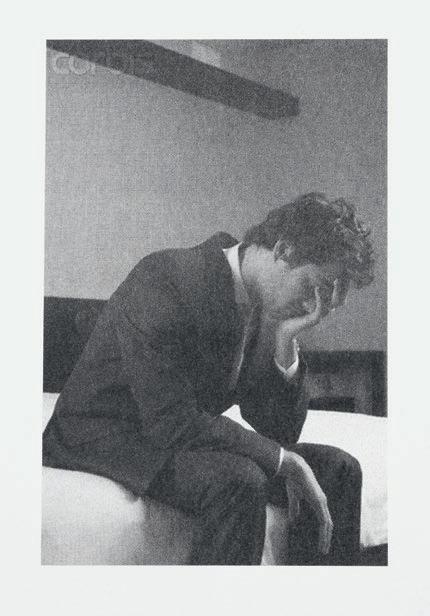


David Horvitz, Sad, Depressed, People, 2012, artist book, New Documents,
Los Angeles. Courtesy the artist & ChertLüdde, Berlin
In the series Sad, Depressed, People, Canadian artist David Horvitz (b. 1982) collects images from online databases that appear when these search terms are entered. What is striking is the recurrent pose with the hands covering the head. On the one hand, the images have a clear connotation. On the other, they are empty signifiers testifying to a certain superficiality because they can be used in various contexts. The work offers a critical perspective on the distribution and commercialisation of images such as those connected to mental health.
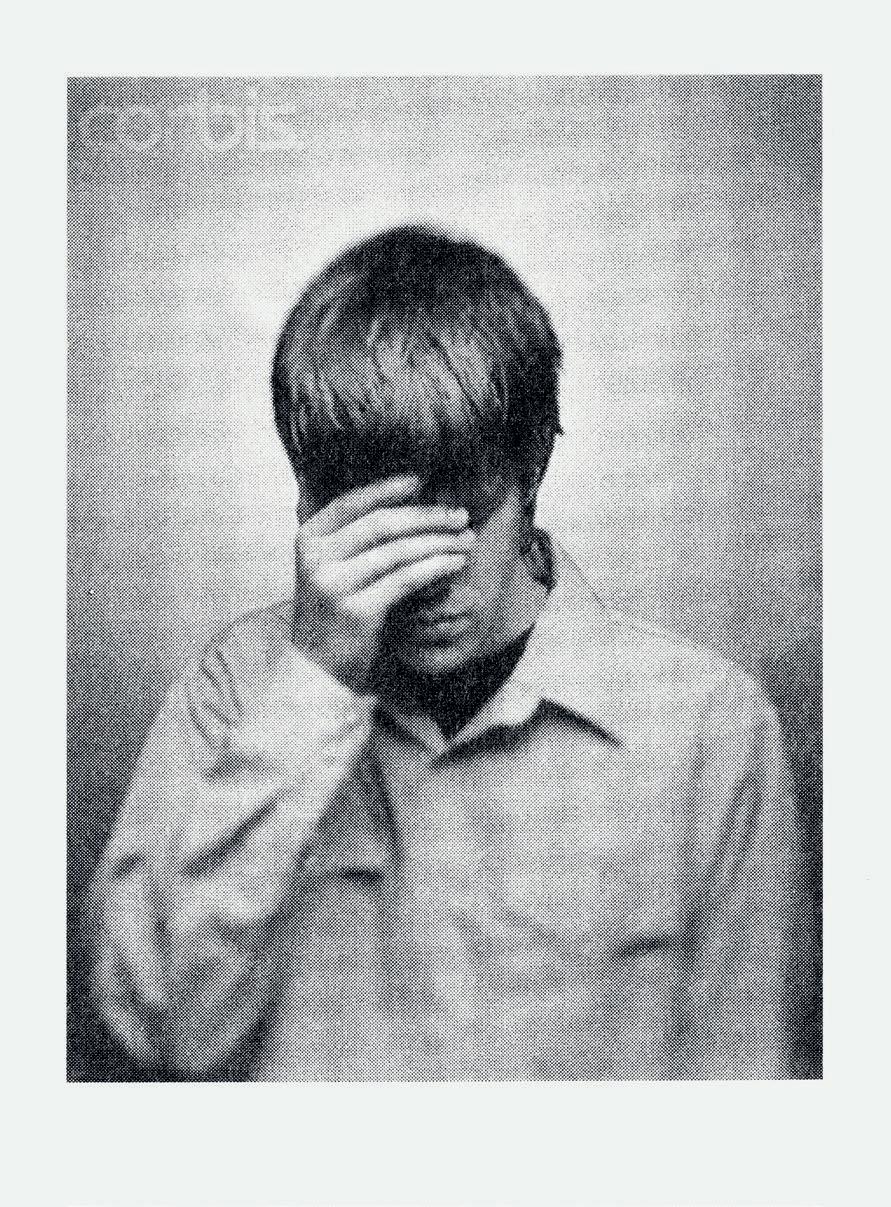
vulnerability a subject of conversation was already being loudly made in the 1960s. That demand is still being made very loudly today. The stigma of mental illness is perceived as a negative remnant of a time when little could be openly discussed. It is demonstrated in the inability to talk about psychological problems and to give them a place. Despite this, mental illness is extensively and continually discussed in many places: the subject is ever present. There is a strong contradiction between individual and social shame and taboo on the one hand, and the dominance of the psychiatric and psychological discourse, on the other hand. The inflation of psychiatric insights in popular media seems to be an alternative way of impeding conversation about psychological problems. A lot is said about mental illness, but precisely what can be said is limited by social norms and values. Power expresses itself not in what you are forbidden to say, but in what you are obliged to say.
Although the opinions of French thinker Michel Foucault (1926–1984) on the history of psychiatry as expressed in his Folie et déraison (1961) are contested, his work about the connection between power and knowledge in discourse is still relevant. Foucault formulated a critique of the ‘classical’ history of ideas of psychiatry (sometimes incorrectly described as antipsychiatric): he attacked the lateeighteenthcentury idea that psychiatry was a science and questioned the authority of figures such as Philippe Pinel, Samuel Tuke and Joseph Guislain. They were not the liberating, humanistic benefactors that their statues might suggest. Instead of the chains from which they were thought to have freed patients, there came a new restraint of mad people, where psychiatric power manifested itself much more subtly, in the position of the psychiatrist as a figure of authority, the observation of patients and, above all, the discourse. The spoken word, and psychiatric terminology in particular, began to dominate thought on psychiatric aberration. Physical means of coercion receded, but they were replaced by a mass of rules, words and norms. Madness was called ‘irrationality’ and then ‘psychiatric illness’, removing it from what it once was.
Foucault wanted to pay attention to that lost, tragic madness by writing, not the rational history of psychiatry, but the archaeology of the silence. The silence was the unheard voice of the mad(ness) as opposed to the discourse of the psychiatrist, and although that voice grew even quieter through the centuries, there
were still, according to Foucault, occasional eruptions. Not in scientific treatises or historical works, but in wild literary texts and uncomfortable works of art. Foucault found traces of what madness used to be before it was medicalised in visual art, philosophy and literature. In his extreme romanticism, he heard and saw the madness in the poems of Hölderlin and the brushstrokes of Goya. Madness echoed in Artaud’s scream and slumbered in Nietzsche’s subversive ideas.
That literature has the means to expose the complexity of power in psychiatry and to question it is clear in our country. The fiery pamphlet Recht op antwoord (Right of reply) that Roger Van de Velde wrote, the bitter monologue of the psychiatric patient Keefman as recorded by Jan Arends, J.M.H. Berckmans’ alter egos who wander through the city, or the manuscripts that the Belgian Frenchspeaking author Sophie Podolski left: they often use a disorientating literary language to reveal what scientific or historical discourses cannot, but they disorientate from within the language itself, because it is precisely in language that a host of norms, rules and opinions are hidden. Dutch author Jacq Vogelaar compiled a collection of ‘disturbed’ texts, texts which occupy the no man’s land between psychiatry and literature, written by anonymous psychiatric patients as well as avantgarde authors. In his introduction, Volgelaar wrote, in imitation of Michel Thévoz who talked of écrits bruts: ‘Anyone who thinks that they are naive, innocent, unmoulded, spontaneous utterances is confronted by very aware, well considered, subversive texts. Disturbed texts are about attempts to escape from language conventions — a rebellion that is also (...) a rebellion against society; their writer is a spoilsport. — How free of consequences is that writing?’
BRAINS BRAINS BRAINS BRAINS
How we read disorientating, disturbed texts and characters is fundamental. The Dr. Guislain Museum houses some remarkable pieces that bring the subject of power and powerlessness in focus on various levels, like the scratches that a visitor can see here and there in the bricks of the building’s external walls. Geometric shapes, years, numbers, tallies ... They are marks that have a documentary but also poetic value. They are documentary in that they function as evidence of the fact that the imposing building, the model of a modern psychiatric institute, served as a place of residence, or passage, for many (often anonymous) lives. The walls
become conveyors of meaning, and that meaning says something different than the therapies and medical theories that the building embodies. But these marks are also poetic, because of their ambiguity and their dependence on the interpretive framework of the person who reads them today. It is impossible to know who made the scratches and what they mean precisely: they might be the scratches of a patient at the end of the nineteenth century who was marking time, but they could just as well have been made by a lovesick pupil who was on a school trip last year. The confrontation with the scratches draws attention to the powerlessness of voices, which could not find their way into the history books, but also to the power of the person who sees and interprets the marks and imposes a meaning on them.
Other remarkable objects in the collection include the patient registers — examples of the administrative machine that psychiatry became in the nineteenth century. Clinical cases and their progress were recorded, often in minute detail. They are often harrowing scenes that are conjured up in detached phrasing. Income and expenditure, the amounts of medication and the duration of confinement have been recorded, including a saddening number of cases where a patient’s decadeslong residency ends with the sobering note ‘dead’. They are fragments of otherwise unobserved lives penned by anonymous writers who could do nothing more than to record what the preprinted categories and tables allowed them. The blotting paper that can still be found in some of the patient registers and with which the psychiatrists or nurses absorbed the wet ink before they started on the next line and the next patient only reinforces, in mirror image, the effect of the words. Those stained and striped pink and yellow pieces of blotting paper were canvases that soaked up that unused ink, as a metaphor for what wasn’t or couldn’t be told.
Even more fundamental questions are posed by an apparently banal collection of notes. Small, folded pieces of paper: backs of cigar bands, Rizla cigarette papers and the foil in which chocolate bars were wrapped, Kwatta or Van den Brink’s Fleur de Hollande. They were found in the cracks and splits of the wooden beams in one of the dormitories of the Dr. Guislain asylum. Various messages are written in the same handwriting, but the name of the author is absent. Some are dated (the 1960s). They are sometimes legible, sometimes not, and they are often puzzling. The vulnerability of the cryptic and hidden messages is disconcerting:


Blotting paper from medical records of the Guislain hospital, early 1960s, ink on paper. Dr. Guislain Museum, Ghent



Notes written by a patient, found between wooden beams in the Guislain hospital, 1960s, pencil and ink on paper. Dr. Guislain Museum, Ghent


De ergste van de toestand des levens (The worst of life)
Eerlijk komt alles uit (The truth will out)
De familie waar (The family in which) De familie toch (Yet the family) De familie familie (The family family) De familie die terug geeft (The family that gives back)
De hersenen hebben coerange (The brain has coerange [sic])
Als het nog anders gaat (If it turns out differently)
Hersentjes (Brains) Hersentjes (Brains) Hersentjes (Brains) Hersentjes (Brains)
What these messages mean is anyone’s guess: they say both little and much.
In his introduction to an unpublished collection of prison letters, the lesserknown text ‘La vie des hommes infâmes’, Foucault talks about how that sort of vague, surrendered utterance becomes visible because it comes into contact with the mechanism of power. It is only possible that we can read ‘Eerlijk komt alles uit’ (The truth will out) in an exhibition or catalogue because chocolate was part of the rations that a patient received, because someone could keep the paper and had a pencil, that there were dormitories and beams that supported the psychiatric building, that someone stayed there long enough in order to be able to write hundreds of notes and could hide them when no one was looking, that the dormitory became a museum gallery and that it was museum policy to keep the notes, etc. It demands a whole system of written and unwritten rules and psychiatric and museum dynamics to make the words readable.
STRANGE POEMS
The brief notes in registers, the scratches on the walls and the maxims on folded pieces of paper kept in the museum form an idiosyncratic collection of evidence. The Hospice Guislain functions in this way as ‘a legend of obscure men, based on the discourse that
they engage in, out of misfortune or rage, with power’ (Foucault, 1977). The artefacts do not belong to the museum’s historicalscientific collection or its art collection. Nor are they literary works. They are suggestions of lives, evoked by just a few words, ‘singular lives that have become, one way or another, strange poems’. These ‘strange poems’ make clear how gestures are hidden in a few scratches that denote the passage of an often nameless individual. They show how power listens and speaks, but also how it determines speech, in the texture of the blotting paper, in the cracks between the beams and the scratches on the bricks, allowing just a minimal space in which to say something that they hadn’t foreseen or do not want to hear. The back of the chocolate wrapper cannot reveal which rules decide what can be said, but it does make tangible that those rules are there nonetheless and that they exercise power. Those rules were present in the period when Guislain erected the walls of the hospice with hope, other rules propped up the discourse of antipsychiatrists and patients during the tumultuous 1960s, and new rules determine what can be said, read and shown today.
Among the hundreds of folded little notes, one stands out. On the back of the foil of milk chocolate is written ‘Tell the truth’. The remark is as noteworthy as the foil on which it is written is not. At first it seems to be an order, an internalised norm, someone telling him or herself to tell the truth, but the note also reveals another layer. The act of speech that the note describes is precisely that which madness or mental illness is not, according to Cartesian logic. Where the mad person once held a marginal but nonetheless important position in society and was thought to speak truthfully, madness lost that capacity because of its medicalisation and exclusion. Madness is regarded as unreal thought, out of touch with reality, illusion, nonsense — in short, the opposite of truth.
A twentiethcentury note from a patient which reads ‘Tell the truth’, written in repugnance at the power structure that undermines the very foundations of the sentence, is an act of rebellion. It is an urgent and complex demand that is made of society and a fortiori of a museum about psychiatry past and present, namely to continuously look for rules that support speaking out and to expose the interaction between power and powerlessness, which is, in any case, revealed by speaking out. What Foucault calls parrhesia — risky, truthful and frank expression — is also a command directed at the viewer, listener or reader and what he or she
wants to read in the surviving, fragile traces: what will he or she dare to say about the scratches? What value do we attach to the words of someone who is mentally ill? What weight is given to the testimony of a nurse? What weight to that of a patient, which is often labelled as unreliable? Who is permitted to say something that can be tested for whether it is true or untrue? How is that right to speak moulded by scientific and ideological motives, by age and gender categories? What determines who can say ‘tell the truth’? What determines who can tell the truth?
BIBLIOGRAPHY Blok, Gemma. Baas in eigen brein. ‘Antipsychiatrie’ in Nederland, 1965–1985.
Amsterdam: Nieuwezijds, 2004 Felman, Shoshana. Madness and Writing. Literature/Philosophy/Psychoanalysis.
Palo Alto: Stanford University Press, 2003 Foucault, Michel. Folie et déraison. Histoire de la psychiatrie à l’âge classique.
Paris: Plon, 1961 Foucault, Michel. ‘La vie des hommes infâmes’, in: id. Dits & écrits, II, 1976–1988.
Paris: Gallimard, 2001 (1977), pp. 237–253 Foucault, Michel. Fearless Speech. Los Angeles: Semiotext(e), 2001 Lotringer, Sylvère (ed.). Schizo-Culture. Cambridge: MIT Press, 2013 (1978) Staub, Michael E. Madness Is Civilization. When the Diagnosis Was Social. 1948–1980. Chicago: University of Chicago Press, 2011 Thévoz, Michel. Le langage de la rupture. Paris: PUF, 1978 Vogelaar, Jacq Firmin (ed.). Gestoorde teksten/verstoorde teksten (Raster 24).
Amsterdam: De Bezige Bij, 1983
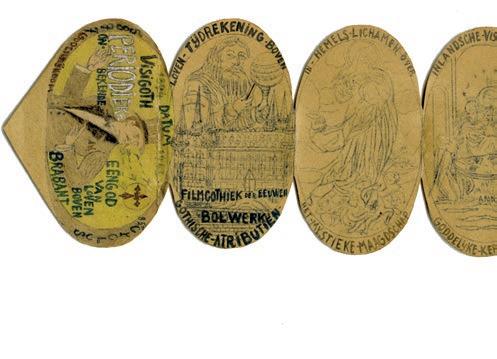

Illustrated letters, undated, paper. Dr. Guislain Museum, Ghent

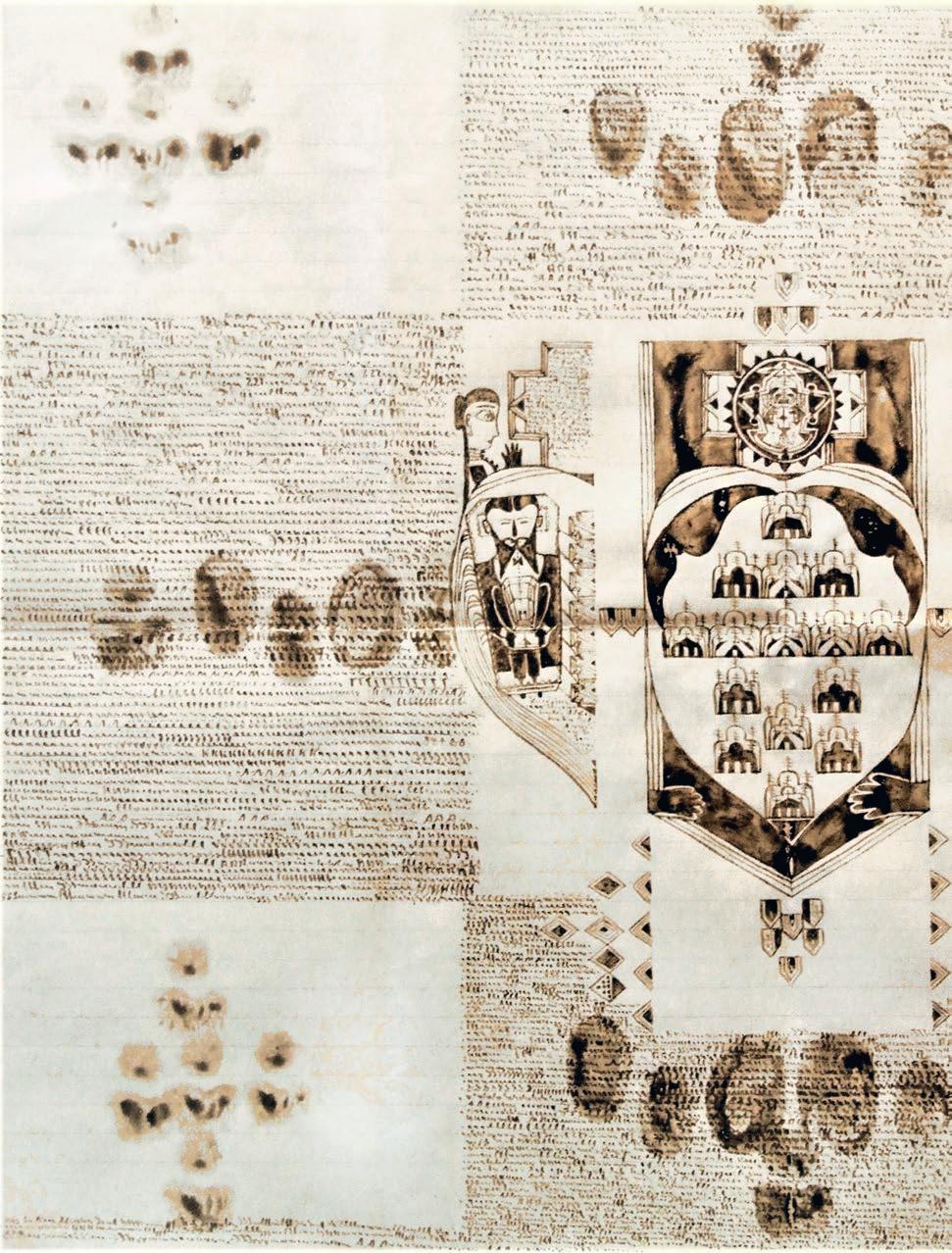

Herman Derive, untitled, undated, blood on paper.
Geel Open Psychiatric Centre
Herman Derive (1899–1957) was a boarder in Geel. He made various drawings, sometimes in his own blood, that have a mysterious language of their own. He called them Des extraîts (sic) de la Sainte Ecriture (extracts from Scripture). Derive was critical of the Geel home-based care system, as Geel doctor Frits Sano noted: ‘Herman Derive claims that hosts are not paid enough for what they have to give the sick people who board with them. He wanders the streets asking for money. He gives the people who give him money a homemade token depicting the Communist hammer and sickle’ (Boeckx & Vandecruys, 2010).

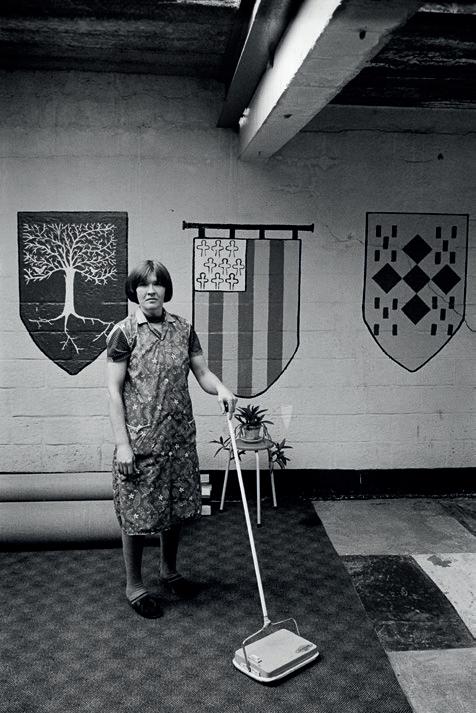
Hugo Minnen, from the series Een gelaat van Geel (A face from Geel), 1978–1980, photographs.
AGB Cultuur Geel, Cultural Centre de Werft
Between 1978 and 1980, Hugo Minnen (b. 1938) photographed the unique, world-famous familybased care system in Geel. Psychiatric patients were housed in host families, a centuries-old tradition that formed an alternative, as it were, to the psychiatric institution. The current trend that focuses on ‘care in the community’ seems to have had a forerunner in the Geel tradition, although the number of boarders in Geel has fallen sharply, and that was already happening at the time of Minnen’s series. Minnen photographed the boarders in their domestic settings, often with attention to poignant details.


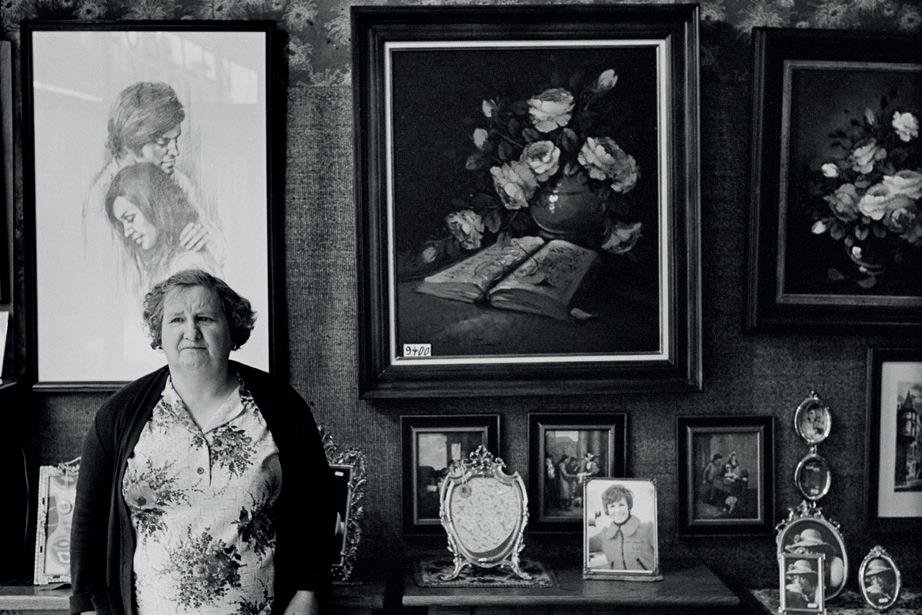


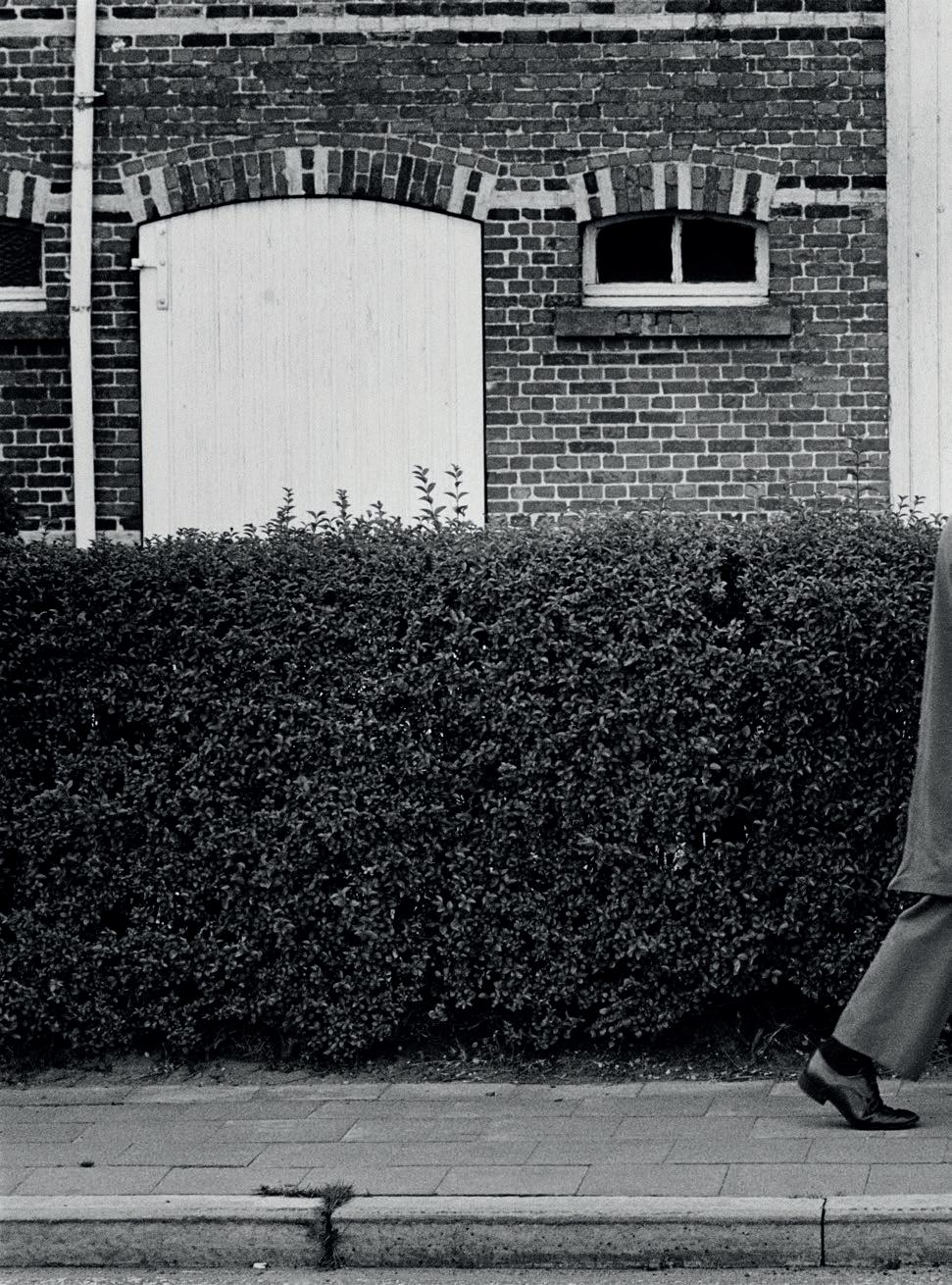


Anonymous, untitled, early twentieth century, pencil on paper.
De Stadshof Collection Foundation. Dr. Guislain Museum, Ghent
Doctor and asylum director J.H. Plokker (1907–1976) was a pioneer in the attention he paid to work in the visual arts by psychiatric patients. His book Geschonden beeld. Beeldende expressie bij schizofrenen (Damaged picture. Visual expression in the schizophrenic) (1962) discusses four remarkable drawings by an anonymous patient. Plokker detects ‘a quasi-profundity that only conceals emptiness’. Besides strange figures and mysterious sayings, the works also depict striking power relationships and figures of authority, such as a doctor and a judge. Opposite an imposing judge is a group of seated figures with conspicuous external features, such as hair in the shape of a claw or a nose drawn as a bird.

Letter, 1983, reproduction. Ludo Serrien archive, Werkgroep Bijzondere Jeugdzorg (1972–1985)
In December 1983, a boy wrote a candid letter to a lawyer. He was staying in a children’s home and expressed the harsh conditions there: ‘if you can’t sleep, they hit you till you do’, ‘if you send a letter they wait until there are no deliveries’, ‘So, Lawyer, they do it for free!’ In the 1970s and 1980s, scandals led to increasing protests. Belief in the institution crumbled. The Werkgroep Bijzondere Jeugdzorg (Youth-Welfare Working Group), led by Ludo Serrien and Jos Goossens, wrote a horrifying black book: a condemnation of a sick youth-welfare policy. It set off a new debate on aid for young people in institutions, children’s rights and the development of Flemish social work.
Pierre Aveline, after Cornelis Visscher, La folie, 1737, engraving. Collectie Nauta, Rotterdam
This striking engraving was made in the seventeenth century by French engraver Pierre Aveline (1656–1722) after a drawing by Cornelis Visscher (1629–1658). Both the image and the text are based on the topos and iconography of the fool. The image shows a grinning, blonde, androgynous figure, clothed in an animal skin, holding a cap with feathers and bells in his left hand and a mask in his right hand, behind his back. The boy is looking directly into the eyes of the viewer. The inscription beneath the engraving reads: ‘La folie. Combien de curieux empressés à me voir— Pouront (sic), en me voyant, se passer de miroir!’ (Madness. How many curious faces, eager to see me, will no longer need a mirror once they see me!). It is a satirical message: the madman is pointing out the madness of the viewer. The mad figure, associated through his clothing with animality, holds up a figurative mirror to the viewer. That was the purpose of the fool in the Middle Ages. On the one hand, as someone of limited mental capacity, he was at the bottom of the social ladder. On the other hand, that position was what gave him the ability to reveal a critical truth about everyone higher up the ladder. According to French science philosopher Michel Foucault, madness is increasingly losing that capacity as it becomes medicalised. The fact that Aveline engraved Visscher’s original drawing in mirror image—left becoming right and vice versa— seems to be a subtle acknowledgement of the critical function of madness, which he represented allegorically.


Gianni Berengo Gardin, from the series Morire di classe, 1968–1969,
photogravure. © Gianni Berengo Gardin. Dr. Guislain Museum, Ghent
In the 1960s Franco Basaglia, the director of the Gorizia mental hospital in Italy, began reforming his institution. He removed the fences and walls around the building, introduced meetings with patients, and pleaded in favour of more humane care. He was among the founders of anti-psychiatry, a movement that saw patients not as passive but as active individuals. In 1978 he succeeded in getting Law 180 passed, with the aim of having all the psychiatric hospitals in Italy closed down. It was a process that would take 20 years. A book that made an important contribution to that movement was Morire di classe by Carla Cerati (1926–2016) and Gianni Berengo Gardin (b. 1930), whom Basaglia asked to photograph life in Gorizia and other Italian psychiatric hospitals in 1968.

Eric Manigaud, Klinikum Weilmünster #6 (Weilmünster Clinic #6), 2010, pencil and
graphite on paper. Artist’s collection, Saint-Etienne. Courtesy Gallery FIFTY ONE. © Adagp, Paris, 2019
French artist Eric Manigaud (b. 1971) is known for his hyperrealistic pencil drawings inspired by existing historical images. The photos from the Weilmünster albums, an early-twentieth-century collection of portraits of patients from the Weilmünster Clinic in Germany, were intended as an inventory of disease profiles. Today we mainly feel a tension between the scientific gaze and the patient’s visible suffering. Two hands restrain a young woman. The patient’s mouth is fixed and she stares into the distance. The photographed subject is subordinated to the recording gaze of the photographer, but her emotions cannot be eliminated. Fear, anger or despair appear in various portraits. What is emotion or resistance and what is a disease profile?



Karel Frans Drenthe, untitled, second half of the twentieth century,
Indian ink on paper. Dr. Guislain Museum, Ghent
The Dr. Guislain Museum collection contains more than a hundred drawings and collages by Dutch author and artist Karel Frans Drenthe (pseudonym of Karel ‘Karlie’ Drosse, 1921–unknown). His work is a ruthless critique of the power structures in the ‘care of the insane’ that he experienced as a patient. It can be seen as an early expression of the anti-psychiatric wave. His cartoon-like works are bursting with gallows humour, sometimes literally, as in the cross-section of the psychiatric cemetery with three coffins under every anonymous gravestone. Drenthe warned viewers about the possible reactions to his work: ‘May I impress upon you most urgently to remain ABSOLUTELY immune to the so-called pertinent claims of physicians who declare that the restraints I have drawn are old-fashioned and medieval. Don’t be deceived. Even if professors get involved. They will collectively attempt to prevent publication, through thick and thin. The restraints are contemporary and IN GENERAL USE.’ Little is known about Drenthe. A short biography appeared in the sixth edition of the literary journal Randstad, edited by Hugo Claus, Simon Vinkenoog, Harry Mulisch and Ivo Michiels, presenting him as a singer and natural athlete, a ju-jitsu and yoga expert, travel guide, stenographer, pianist and author. Drenthe wrote about the law on the insane, the role of the ‘work ethic’ (‘Anyone who does not want to work is inevitably considered to be mentally ill’) and electric shock therapy: ‘I have seen many terrified patients, dozens of times, fighting to avoid electrocution. On doctors’ orders, they are mercilessly tackled and dragged away by the nurses, sometimes even tied up, only to be returned ten minutes later, unconscious, mumbling and groaning on a stretcher.’

Klaas Koppe, from the series about the conference Strategie van de kleinschaligheid (Scaling-down strategy) in Leuven, including Steven De Batselier and Ronald Laing, 1981, photographs. © Klaas Koppe
In September 1981, Dutch photographer Klaas Koppe attended the conference Strategie van de kleinschaligheid in Leuven. It gathered psychiatrists from around the world with the aim of mapping out the future of the anti-psychiatric movement. Ronald Laing, Kees Trimbos, Félix Guattari, Steven De Batselier, David Cooper, Vincenzo Caretti and many representatives of therapeutic communities and patient associations were present. It was a tumultuous conference. On the one hand, general political stances on psychiatry were discussed. On the other, new forms of therapy were presented. The discussion of prenatal deep-sea-diving therapy—which claimed that consciousness begins before conception—even included sessions in a swimming pool (and psychiatrists in swimming trunks). ‘But don’t new therapies like this lead to new forms of psychiatric authority?’, various attendees wondered. Suddenly one participant dropped his yellow shorts and dived into the pool: ‘Splash: the first incident, you’d think. But in fact, no one saw it as a form of protest’ (Schrameijer, 1981).
However, the conference itself was the target of protest. Attending patients had their say, whether they were asked or not, and although patient participation was at the heart of anti-psychiatric thinking, intervention was ultimately required. The overly large scale of the conference led to revolt—large groups left the auditorium on several occasions. In hindsight, the conference presented a picture of the final days of a revolutionary movement. From the 1980s onwards, psychiatry would develop in a different direction. And nothing could change that, not even a figurehead of anti-psychiatry like Ronald Laing, playing ‘It’s a Long Way to Tipperary’ on the piano to calm tempers at the conference.





Christian Fogarolli, archival research at the Mental Health Centre Gorizia (Italy), 2018, photograph
Italian artist Christian Fogarolli (b. 1983) is developing an intriguing oeuvre of installations in which various media enter into dialogue with each other. Psychiatry and madness are central to many of his works. Fogarolli has made new work for the Dr. Guislain Museum, using the museum archives as a source of inspiration. His artistic research focuses on the hidden links between the work of Joseph Guislain (1797–1860) and the thinking of Italian psychiatrist and reformer Franco Basaglia (1924–1980).

Karin Borghouts, from the series Museum Dr. Guislain, 2019, photograph. Dr. Guislain Museum, Ghent. © 2019 – Karin Borghouts / SOFAM – Belgium POWER AND POWERLESSNESS— 249

Wolfgang Hueber, Du Schwein, 1988, pencil and paint on canvas.
De Stadshof Collection Foundation. Dr. Guislain Museum, Ghent

Man in straitjacket, 1890s, glass negative. Dr. Guislain Museum, Ghent
German artist Wolfgang Hueber (1950–2008) lived permanently in a psychiatric hospital from 1985 onwards. He made quick sketches of figures and tools, then coloured them in. He used ordinary metal tools that he took apart, melted down and turned into stylised weapons, often pistols or knives. Hueber classified images into three categories: true, really true and lying images. Du Schwein, a painting that depicts a doctor trying to hurt a patient, belongs to the category of true images.



(this and previous pages) Karin Borghouts, from the series Museum Dr. Guislain, 2019, photograph.
Dr. Guislain Museum, Ghent. © 2019 – Karin Borghouts / SOFAM – Belgium







